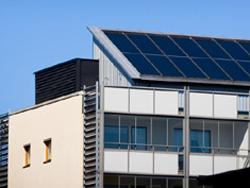Green Homebuilding Slowed by Costs
"
Homebuilders are crucial to reducing greenhouse-gas emissions believed to cause global warming, according to Ed Mazria, founder of environmental-activist group Architecture 2030. He estimates buildings - their construction and operation - contribute 48 percent of overall emissions while transportation adds 27 percent and industrial activity 25 percent.
Certainly, there has been frustration among some of the largest homebuilders about finding the right cost formula. Estimates vary widely for how much green building can add to the final price, with the lower estimates at 3 to 5 percent versus higher predictions of 10 to 15 percent.
Ara Hovnanian, head of one of the nation's biggest homebuilders, said all other things being equal, consumers would choose green. But, he said, all is not equal.
"Consumers have not been willing to make the investment," said the CEO and president of Hovnanian Enterprises Inc.
Hovnanian was one of 10 homebuilders that developed an all-green community called
"
Recouping that premium is more of a problem for developers who build properties for sale, as opposed to those who can benefit later from lower electricity bills or being able to charge higher rents. Investing in green features ultimately benefits the home buyer, so if the consumer is unwilling to pay more, the cost-benefit formula makes no sense, in Hovnanian's view.
Bill Valentine, chairman of architecture firm HOK, said the main goal for architects who support green building is to get sustainability into the common consumer's budget.
"
Mazria of Architecture 2030 and others say that's about to happen.
"I think we're just seeing the beginning of a total transformation of the building sector," Mazria said.
Mazria said a number of different parties are working on proposals to extend the tax benefits in the Energy Policy Act of 2005, which could encourage growth in green building. He said two New Mexico Democrats, Rep.
"It is a very small price to pay for mitigating the potential impact of climate change," Mazria said.
Among the early adopters are two smaller homebuilders, Los Angeles-based Pardee Homes and Florida-based WCI Communities Inc.
Pardee Marketing Vice President Joyce Mason said one-third of about 10,000 homes it has built since 2001 are in its Living Smart line of homes, which come with carpet made from recycled soda bottles and wood from managed forests. She said consumers had always appreciated the green features, but buyers have started specifically asking for them in recent months.
"We saw it first happen in hybrid cars," Mason said. "I think it's probably going to shift over to houses."
Karen Childress, environmental stewardship manager for WCI, said it first built a green-home prototype in 2001 to explore energy efficiency, and has experimented with a growing list of features since then. Its latest project is working with the
Researchers are developing energy-saving methods to move toward that ideal.
James Sweeney, director of the Precourt Institute on Energy Efficiency at
"
